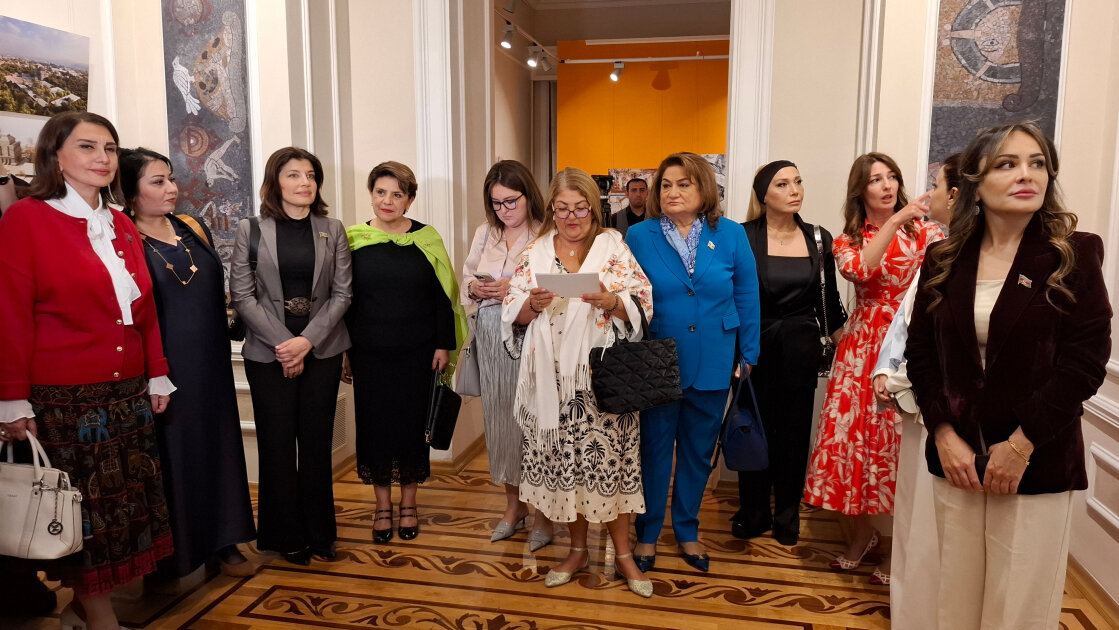The exhibition is jointly organized by the Embassy of Mexico in Azerbaijan, the Ministry of Culture of the Republic of Azerbaijan, the Anahuacalli Museum, and the Azerbaijan National Museum of Art. Dedicated to the world-renowned Mexican artist Diego Rivera (1886–1957), it marks the Anahuacalli Museum’s first project presented on an international scale.
Featuring nearly 100 photographic reproductions, the exhibition showcases Rivera’s artistic legacy, including murals, paintings, sketches, archival photographs, and documents. Visitors are given the opportunity to closely explore the unique creativity of one of the greatest artists of the 20th century.
At the opening ceremony, speeches were delivered by Shirin Melikova, Director of the Azerbaijan National Museum of Art; Victoria Romero, Ambassador of Mexico to Azerbaijan; Telman Ibrahimov, PhD in Arts; and Teresa Moya, Director of the Diego Rivera Anahuacalli Museum. They highlighted the significance of the exhibition, emphasizing that Diego Rivera’s art reflects universal values and constitutes an integral part of Mexico’s cultural heritage. The speakers also noted that the exhibition strengthens cultural ties between Azerbaijan and Mexico, expressing gratitude to the organizers.
The exhibition is divided into five main thematic sections that outline Rivera’s key role in Mexico’s social transformation. These sections cover his reflections on art, his position in the muralist movement, the synthesis of painting and architecture, and the social role of art in post-revolutionary Mexico. The displays reflect Rivera’s deep engagement in the Mexican Revolution, public education, and the role of art as a tool for civil society. Visitors can see how Rivera emerged as a leading figure in Mexican muralism, viewing art not only as an aesthetic medium but also as an instrument for education and the formation of public consciousness.
Photographic reproductions of Rivera’s mural “Creation” (1922), painted at the National Preparatory School in Mexico, hold a special place in the exhibition. This monumental work is regarded as the beginning of Mexican muralism and demonstrates a synthesis of Renaissance style with local motifs. Later projects, including murals at Chapingo and the Ministry of Public Education in Mexico, are also featured.
Reproductions of murals at the National Palace in Mexico City and the Palace of Cortés in Cuernavaca illustrate Rivera’s ability to depict history as a social struggle and highlight the importance he placed on indigenous culture. Rivera’s international activities are also thoroughly represented. His mural “Man at the Crossroads,” created in 1933 at Rockefeller Center in New York, caused controversy and was destroyed, but Rivera recreated it in Mexico at the Palace of Fine Arts under the title “Man, Controller of the Universe.” Documentary footage of this work is among the exhibition’s highlights.
A central section of the exhibition is dedicated to the Anahuacalli Museum, created on Rivera’s initiative. Designed by the artist and located in Mexico City, this unique museum was built from volcanic stone and intended to bridge ancient heritage, modernity, and the future. Architectural plans, sketches, and photographs in the exhibition vividly illustrate Rivera’s vision of preserving cultural roots while inspiring future generations.
The exhibition project was realized through the initiative of Ambassador Victoria Romero and the joint efforts of the Embassy of Mexico in Azerbaijan, the Mexican Ministry of Foreign Affairs, the General Directorate of Cultural Diplomacy, and the Anahuacalli Museum. It highlights the role of art in cultural diplomacy, presenting Rivera’s artistic vision rooted in the social struggles of the Mexican people to an international audience.
The exhibition will remain open to visitors until December 30, 2025.
 On October 14, the Azerbaijan National Museum of Art hosted the opening ceremony of the exhibition “Diego Rivera: The Promise of a Better Future,” organized by Mexico’s Diego Rivera Anahuacalli Museum.
On October 14, the Azerbaijan National Museum of Art hosted the opening ceremony of the exhibition “Diego Rivera: The Promise of a Better Future,” organized by Mexico’s Diego Rivera Anahuacalli Museum.